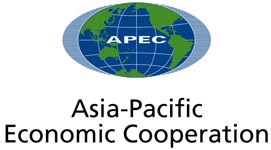The Latin America of free trade braces up for APEC summit
 Buenos Aires - Latin America's free-trade advocates are usually quiet, but they are set to come to the fore this weekend at the Asia-Pacific Economic Cooperation (APEC) forum in Lima, Peru.
Buenos Aires - Latin America's free-trade advocates are usually quiet, but they are set to come to the fore this weekend at the Asia-Pacific Economic Cooperation (APEC) forum in Lima, Peru.
The three Latin American members of APEC - host Peru, Mexico and Chile - are all to the right of the louder presidents Hugo Chavez of Venezuela or Luiz Inacio Lula da Silva of Brazil in the political spectrum.
Moreover, for all Chavez's blasting the evils of capitalism and for Lula's hurdles on the free-trade process around the Doha Round of talks at the World Trade Organization (WTO), Mexico, Chile and Peru have insisted on a pursuit of bilateral free-trade agreements with countries around the world, even at a time of crisis.
"It makes me laugh to read new announcements of the death of global capitalism. They have put so many tombstones on investment and free competition that it is ironic and even innocent to see another tombstone, this time saying that the international system is over," Peruvian President Alan Garcia said earlier this month.
Mexico - the 14th-largest economy in the world according to the World Bank - joined APEC in 1993, while Chile followed suit a year later and Peru became a member in
1998.
They are keen members of the organization and are working to have Colombia join the group in 2010, when the current moratorium on new members ends. Indeed, Colombian President Alvaro Uribe is set to attend the APEC meeting in Lima as a guest.
Other Latin American countries, notably Costa Rica, Ecuador and Panama, are also keen on joining the group.
Indeed, APEC's Latin American countries are set to make the most of the upcoming meeting in Lima to negotiate towards the creation of a Pacific free-trade area including the main Asian economies, Canada, the United States and the 11 Latin American countries that make up the Latin American Pacific Arc Initiative.
Based largely on immigration currents, Peru has long been oriented towards Asia - not least under the Presidency Alberto Fujimori (1990- 2000), who holds both Peruvian and Japanese citizenship and tendered his resignation from Japan.
"Most of the trade deals that Peru has signed or is negotiating are in the Pacific area: the United States, Canada, Mexico, Chile. We will soon be (signing deals with) China, Thailand, Singapore, we are getting closer to Japan, South Korea, and next year we will be launching negotiations with Australia," Peruvian Foreign Trade Minister Mercedes Araoz said recently.
In the current context, such a setting helps, she noted.
"This diversification of the geographical trade and investment spaces helps us to dampen the impact and helps us get out (of the crisis)," Araoz stressed.
Current Peruvian President Alan Garcia - whose term is set to expire in 2011 - had a first term 1985-90 on a social democratic platform with very poor results, but now appears to be following a more free-trade-oriented path.
A corruption scandal led to a cabinet reshuffle only last month and Garcia's popularity is extremely low, with only 19 per cent of the population approving his work and 77 per cent explicitly disapproving of it according to an opinion poll that was made public this week.
However, the Peruvian economy grew by 10.08 per cent in the first nine months of 2008 and has experienced growth for 87 consecutive months, according to the authorities.
In May, Lima hosted the EU-Latin America-Caribbean (EU-LAC) summit, although by then the world was worried by soaring food prices rather than by a far-reaching global financial crisis.
Peru has a GDP of 109 billion dollars and a population of some 29 million, 44.5 per cent of them living under the poverty line.
Lima itself has a population of 7.6 million, with close to an additional million living in the city's metropolitan area. (dpa)